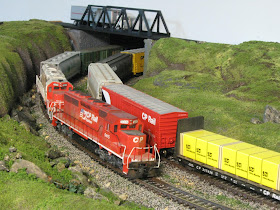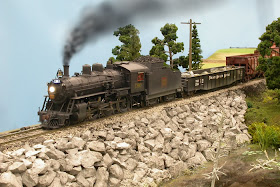Thursday, August 30, 2012
Great Canadian Model Railroad: The S Scale Workshop
So far, this blog has featured the following scales in its Great Canadian Model Railroad series: N, HO, O, On3 and G. What’s missing? Oh, yeah—S scale!
Not anymore; let me introduce you to the S Scale Workshop, nine modelers from Ontario and Quebec (David and Oliver Clubine, Jim Martin, Chris Abbott, Pete Moffett, Andy Malette, Trevor Marshall, John Johnston, Simon Parent) who operate an S scale FreeMo layout representing CN in Ontario in the 1950s.
Formed in 1995, the group came together to show the fine scale potential of S scale. The first layout was an 11 by 20 foot sectional layout called the Ridgehill Central. The layout, which used code 83 rail, was dismantled in 2005 and replaced in 2006 with the FreeMo modular format.
The current layout stretches over 100 lineal feet and is operated as a point-to-point, single track branch line with turntables at each end.
Track is code 83 and code 70 handlaid or Tomalco flex track. Many switches have been built using FastTracks fixtures. DigiTrax DCC is used to power the layout, and the scenery is cohesive from module to module.
The layout was featured in the May, 2008, issue of Railroad Model Craftsman and Train 16, Track 2 issue of Canadian Railway Modeller.
The layout is shown 3-4 times a year, mostly in the greater Toronto area, although the group took it to Trainfest at Milwaukee in November, 2011—where it won Best in Show: Layout. The next big trip is to the big Springfield show in Amherst, MA.
You can find out more about their layout on their website. They also have a blog where you can learn more about their construction and other methods.
I guess that just leaves Zed scale (that's how we say "Z" in Canada) to go!
Sunday, August 26, 2012
Private Owner's Train in Minneapolis-Saint Paul
In July I took a short vacation to Minneapolis-Saint Paul. While there, I did a little railfanning (of course). In addition to catching a little CPR action, as in the photo above, I stopped in at the Saint Paul Amtrak Station--where I happened upon a string of private passenger cars.
In the string were the following cars:
The Budd dome Sierra Hotel (ex-CB&Q 251 Silver Lounge). The car, which is available for rent, has four bedrooms and comes with a chef and steward.
Caritas observation car, built as a 14 roomette, four bedroom sleeper for the StLSF in 1948.
Ex-Army hospital car 89553, built in 1953 by for the U.S. Army and acquired by Amtrak in 1973 and reconfigured to Le Pub bar-lounge 3403. It was rebuilt early 1980s to Heritage lounge 3103 and refurbished by Railroading Heritage of Midwest America (RHMA) as Milwaukee Road Wisconsin Valley in 2001.
Beside it was Superdome 53, built for the Milwaukee Road by Pullman Standard in 1952. It was acquired by CN in 1964 and named Athabaska. It was sold the Chicago & North Western Railway for business service in 1986 and renamed Powder River. It was acquired by RMHA 2005.

MKT 403, originally built in 1913. The car was built specifically for the Vice President of The MKT Shops. The car is owned by a private collector, and is based in Orange Park, Florida.
Hiawatha observation car, designed by famed industrial designer Brooks Stevens and built by the Milwaukee Road in 1948. Retired in 1970, it as acquired by the RHMA in 1998 and returned to service.
To the east of the station was the Gritty Palace, ex-Rock Island office car #98 built by Pullman in 1912. The car’s reporting marks are GNW&B, which apparently stands for Going Nowhere & Back.
I can't afford to own or ride on a private passenger car, but longer-time readers of this blog may remember that a private owner's train regularly traverses my layout; you can read about it here and here.
(The Milwaukee Road cars in the consist above are owned by Railroading Heritage of Midwest America (RHMA), formerly the Friends of the 261, a non-profit organization whose mission is to promote public understanding of the history of railroading in the Midwest. The RHMA owns a fleet of passenger cars, most of them painted in Milwaukee Road maroon and orange passenger train colors, which travel with Milwaukee Road 4-8-4 261.)
Tuesday, August 14, 2012
Waterloo Region Model Railway Club Featured in Model Railroad Hobbyist
Earlier, I wrote about the Waterloo Region Model Railway Club, a great Canadian model railroad that features CP Rail in Sudbury, Ont. in the 1970s. That unique and inspiring club has now been featured in Model Railway Hobbyist, the online model railroad magazine.
Click here to read the feature (found in the second half of the magazine). In addition to the text and photos, there is a detailed plan of the six-level (yes, six) layout. The club uses ten (yes, ten) helices to get the trains from one level to another; you can read about them, and see photos, here.
Saturday, August 11, 2012
A Railway Museum for the CP Rail Manitoba & Minnesota Subdivision
 |
| A CP Rail freight passes the museum in Turney, Man. |
Many small towns on railway lines—or former lines—have them: Small displays of railway equipment, memorials to the time when the train once stopped there, or when they were home to a yard or engine terminal. Places like the towns below.
 |
| Edson, Alberta |
 |
| Sioux Lookout, Ont. |
 |
| Agassiz, B.C. |
 |
| Winnipeg Beach, Man. |
Sometimes it’s an old locomotive, or maybe a freight or passenger car or, many times, a caboose. Sometimes the equipment is in great shape, sometimes in poor condition. Occasionally, like with the passenger cars in Florenceville, New Brunswick (below), they become home to businesses, such as a fine restaurant.
Whatever is there, it’s a testament to another time when the town was really on the map—a time when train-time was a big time. But now the trains fly by, or have stopped running by or through the town at all.
For the town of Turney on the CP Rail Manitoba & Minnesota Sub., it’s the former. A once busy railway town now watches a parade of trains pass by on their way to somewhere else. But that time long ago is still remembered in a little museum in the old freight house; outside, on a disconnected piece of track, an old caboose and GP 7 recall the good old days.
That’s one story. The other is that when reconnecting tracks on the layout to the staging yard in the other room, about a foot of unused space, which once housed the old mainline, became available. My first thought was to just turn into a rolling hill with trees. But then I thought: Why not lay some tracks on the old right-of-way and use it to create a museum?
And that’s what I did.
I haven’t seen this done much on a model railroad. I can recall photos one or two layouts that had a steam locomotive in a downtown park, but that’s about it.
As for the museum itself, perhaps one day I’ll buy a steam locomotive that doesn’t run anymore and put it on the tracks. Or maybe an old passenger car, or a 40-foot boxcar, or a CPR caboose from a bygone era.
Whatever ends up there, I think it’s an interesting, and little-used, scenic feature for my layout. Maybe I can also include a sign, like the one below.
Caboose photos by Art Grieve and James Booth from Your Railway Pictures.
Twin City Model Railroad Museum: Toy Train Division
No visit to Minneapolis/St. Paul is complete without a visit to the Twin City Model Railroad Museum at Bandana Square—and no visit to the Model Railroad Museum is complete without a visit to the Museum’s Toy Train Division, located next door.
The Toy Train Division is a must-see place for anyone who likes three-rail model railroading—and even for those of us who model in other scales.
The Toy Train Division came about after a local modeler donated his extensive collection of Lionel trains and equipment to the Museum. In addition to the layouts, the Division features many displays of Lionel and other three-rail trains, along with a fully-equipped workshop.
The Division has about 20 layouts, ranging from three-rail O scale to S, HO, N scale, Marx and Marklin. The day I was there I think 16 of them were in operation. Yes, it was noisy!
Several of the layouts are set up so kids can operate them; maybe this is where future model railroaders will come from.

A highlight of the Division is the layout depicting the Minneapolis Mill District in the 1950s. It was donated to the Museum by Michael Corrigan, a former Minnesotan now living in California. The 16 by 30 layout was built by professional layout builder Clarke Dunham. See photos of that spectacular layout below.
For me, the Toy Train Division was a trip back in time to when I was a kid, watching my Lionel trains speed around the track on the floor . . . and they still really speed! It’s impossible to take good photos of the trains at the Toy Train Division, unless you have a very fast shutter speed or they are standing still.
Entrance to the Toy Train Division is included in regular Museum admission. The Toy Train Dvision is only open on weekends, though.
Monday, August 6, 2012
Holiday Railfanning on the M & M Sub.
The first Monday in August is a holiday in most of Canada. It goes by different names in different provinces, and celebrates different things. But, at base, the main reason for the holiday is that our summers are short--we need all the long weekends we can get!
The day off is great for a bit of railfanning--like what I did on the CP Rail M & M Sub. One of the nice things about finishing a new scene is taking photos of it (except when the photos expose the flaws--although even that is useful). Here are a few railfan shots of the new area that hides the hole on the upper level of the layout.
(For more about the process of hiding the hole, click here.)
Saturday, August 4, 2012
Hiding the Hole, Part IV: Done!
After a month or so of on-and-off work, the hole in the wall is hid. Now operators won't be able to see where the staging yard joins the layout; the trains "mysteriously" appear before their eyes.
There's still more work to do the right of the scene--got something unique planned for that. But now, at least, the upper level is more-or-less back together; now to tackle the lower level of the layout.
To re-cap the process of hiding the hole, see the photos below. Links to previous posts about hole hiding are at the bottom.
 |
| The hole. |
 |
| The hole-hiding hill is added. |
 |
| Ground foam added, and a bridge. |
 |
| Background trees in place. |
 |
| "Real" trees planted. |
 |
| How the scene looks at operator eye-level. |
Previous posts in this series:
Hiding the Hole Part III
Hiding the Hole Part II
Hiding the Hole Part I







































